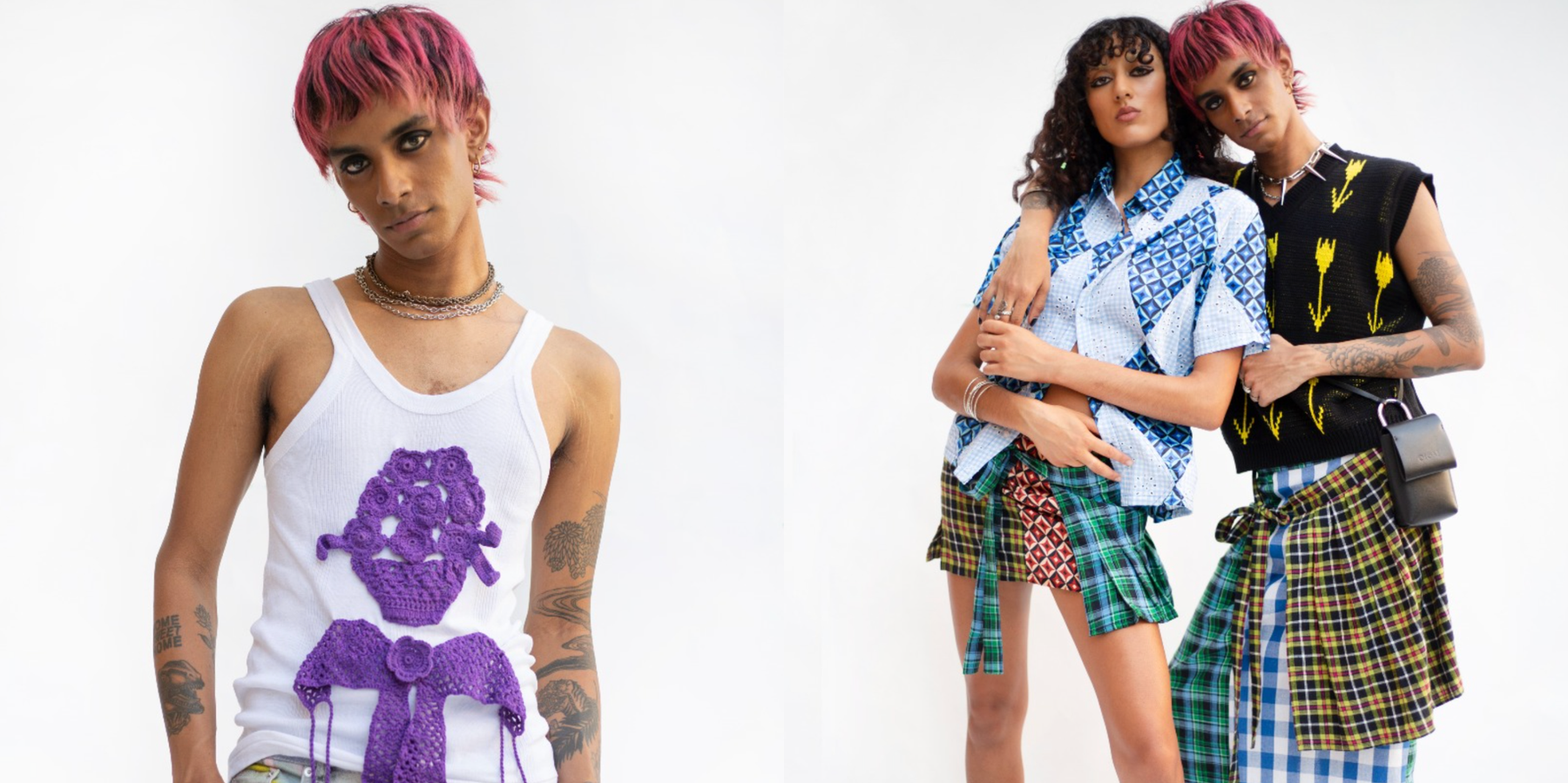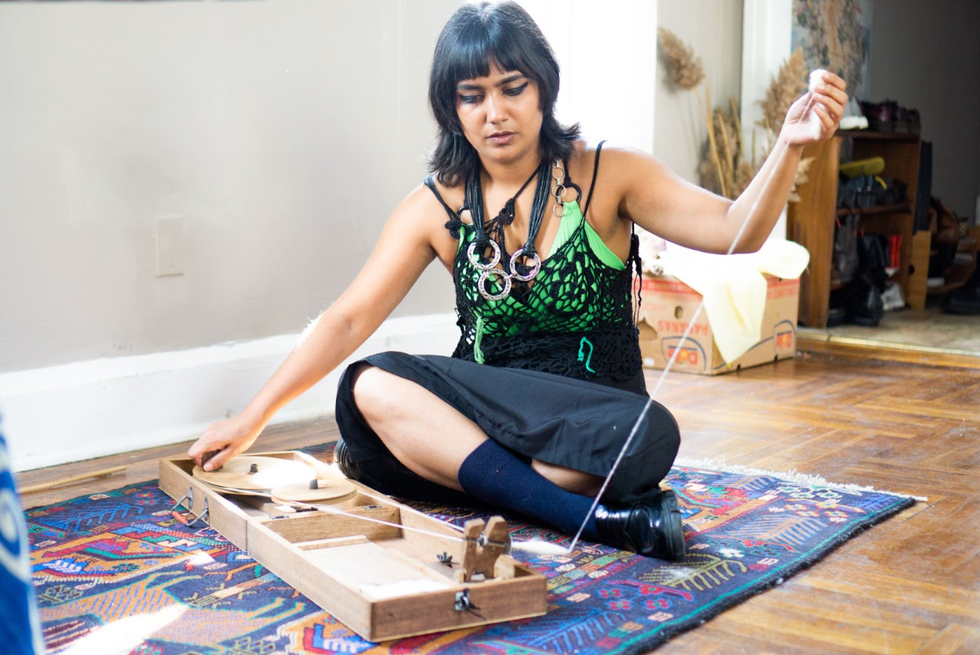
Fashion
The Textile Artist Putting an Indian Punk Spin on Heirloom Craft
by Siddhant Talwar
23 August 2022

With sustainability a mainstay topic in the fashion discourse, the debate on size and price accessibility within sustainable fashion has never been more in the spotlight. The newest foray into this space comes from the textile artist Shradha Kochhar, one of the minds behind the Indian brand LOTA.
LOTA used to work with waste to make eclectic pieces that would be auctioned off on social media. Since starting LOTA, Kochhar moved to New York from India, got her MFA from Parsons and worked with the likes of Collina Strada and Tory Burch, and she also collaborated with Marshall Columbia on a capsule collection. Her work has been exhibited at Donna Karan‘s Urban Zen gallery as well as Mana Contemporary.
Now, Kochhar is starting a new line after announcing that LOTA will be shutting down. The label, called imli dana, is an independent textile studio with a focus on generational textile techniques and celebrating that labor. PAPER caught up with Kochhar in her sunny Crown Heights home studio to learn more about the brand.
What's behind the new name?
I think the name imli dana was this idea of collective beads, these dots that become a bigger whole. And that's what Dana means, bead. And I think I've always been really fascinated with this idea of food and clothing. At LOTA, we would have all the shirts called by these names that make you feel a certain way. I think for Hindi speakers, imli automatically takes you to this cheeky place, khatta (sour)...even though when you put it together, it's not an actual word. But I feel like it just felt like the right mix of two things and two ideas that I really cared about.
I love that. So how did you end up here? What draws you to textile work?
My textile practice is more art focused. It's about self-reliance and self-sufficiency in systems. And that's kind of what Khadi is about. Being able to know how to make your own clothes, being a maker, rather than a consumer, was really where the whole ideology of Khadi lies. In the middle of COVID that textile practice really bloomed to where it is now. And a lot of it was talking of grief, and really making sense of the reality I was living. So it was very personal. imli dana feels more shared. And I think my art practice is definitely more internal and more sacred in my life.
Why not continue LOTA, instead of starting imli dana?
LOTA was literally at the intersection of technology and craft. And I think over the last three years, I was engaging in such laborious work, like, time consuming, energy consuming, soul sucking that I really stepped away from technology. It just became very evident that I didn't actually feel as excited about technology. My personal mission is not what LOTA does anymore. And also, I think with the pandemic, there was just so much loss and so many attachments that it needed a fresh start. We lost a very important part of our team. That just changed our attachment to the brand and how we work with the brand. So it was time for a fresh bloom.

Photography: Siddhant Talwar
What are your thoughts on the word sustainability and how does imli dana strive for real sustainability?
It's become this word that's just thrown around. I genuinely think sustainability is caring for people. The systems that we operate in today, people are not happy. The farmers are not living a respectful life, the makers are not living a respectful life, the designers are probably not living a respectful life. Sustainability cannot be in isolation from the community. imli dana is still doing upcycling because we're working with the same people from LOTA and we're still giving them the same jobs.
We directly work with manufacturers of major clothing brands and we collect that waste in bulk in India. And that becomes raw material. We use that to make new virgin fabrics that can be then used to make anything and that’s how we make our upcycled pieces. In Imli Dana there is a lot of work that's hand knitted, and hand crocheted between me and my grandmother. So she would make half the piece, I make half the piece, and then I kind of put it together in New York. So it's just really like how clothes were made back in the day, which is just being more appreciative of the craft and just appreciating this thing that took hours of labor and time and someone's heart and soul.
It feels like your focus on community and intergenerational work is a big asset.
Absolutely, my Dadi (grandmother) started making sweaters to get her family out of financial hardships. And that's big baddie energy. And I want my pieces to be intergenerational. I want everyone to have this moment where they can pass these pieces on and they just read two names, and they know who made this and that it was these two people from different worlds coming together to make things.
imli dana feels very timeless but also current, it seems to have more edge than LOTA. Where does the inspiration for these come from?
I love color, I'm someone who wears so much color and I think I just wanted to tap into that. In my head it is also a little gritty and it is a bit grungy and it's like its own version of Indian punk. I don't think there's an actual vocabulary around that and in fact maybe I don't know enough but we do love color. We live with color, but color doesn't equate to cheery-happiness.
It's interesting because a lot of this does read as Indian streetwear to me. However, that style is never validated by the fashion world.
It's so sad, that's why I make these clothes. I've grown up seeing stuff like that. I've seen my Dadi in like salwaar kameez with this weird juxtaposition of the oddest patterns and colors and they're all clashing and they're so chaotic. There's like this sense of chaos, but it's so fun.
You've worked with Tory Burch, Marshall Columbia and Collina Strada. What have those experience taught you about creating a brand and making it stand out
I think I learned so much from everyone. And very different things from each person. I think from Marshall, I learned how to build equitable partnerships. I genuinely respect him so much for making me feel like an equal especially when you don't expect that out of the fashion space. I think Collina Strada, Hillary knows exactly what she likes and what she doesn't. She can see five steps ahead. And I think that's such a good trait for someone who's leading or is just trying to build something. Like knowing exactly what you want. I think Tory was really interesting, because the infrastructure she built is so fascinating. It's gives you hope that you can do this, like you can actually make your practice sustainable and have it affect a gazillion lives.
There is a lot of conversation about accessibility in sustainable fashion, especially when it comes to price and sizing. As a brand with premium prices is accessibility a goal for the future? Is it even realistic?
I'm hopeful. I'm an idealist in my head. I try to do the right thing. And then if I don't, then I learn from it. LOTA we started doing just one size, which was like a medium large. And we would do custom pieces for people. We wanted it to be as conversational as possible. Then we learnt from that experience that not everyone will reach out to you and will feel comfortable asking you. I wanted to do sizing right. But you have to build a vocabulary around sizing which isn’t gendered.
I think finding that balance between what makes a maker feel respected and valued and then the consumers feeling like they have access, it's why the shirts are cheap, but at the same time again, a lot of my friends in India can’t buy it and that makes me so sad. But I have to value my process. And if I want this to be sustainable, I have to pay my photographer, models, makeup, my rent and I'm not even counting the visa fees.
You’re finally here and you have started to get orders and responses. What’s next on the horizon? What are you excited about?
I'm really excited about my upcoming residency. I haven't had a single minute to think and be idle. And the residency is in Houston so very close to cotton and the very violent history of cotton. They're sort of a museum slash educational space. So I'm kind of excited to take some time to just read and write and make sense of the work that I'm doing, but also kind of bring my hands to my brain and kind of tie the whole ecosystem together. As someone who's now living between two continents, both with such dramatic sort of violent histories with cotton I'm excited to find where my space lies in this conversation or does it not? Like can I maybe just have more awareness of these resources and spaces? Can I connect these intercontinental resources together for something?
Top photo: Courtesy of Tarishi Guptaa